 |
|
|
|
 |
| |
I) |
Detection and manipulation of spin states of individual magnetic atoms and nanostructures on non-magnetic metal substrates based on SP-STM
Y. Yoshida
|
|
|
| |
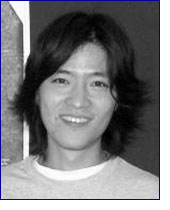 Low-dimensional quantum magnetism is one of the hottest topics in condensed matter physics, especially after P. W. Anderson hypothesized that the quantum spin-liquid state called "Resonating Valence Bond" of CuO 2 planes of High-TC superconductors plays an important role to achieve superconductivity at such high temperatures exceeding the BCS limit. However, the samples have been limited to bulk materials so far and the breakthrough to establish rigid theories did not come yet. Therefore, constructing and investigating various kinds of low-dimensional quantum spin systems in a bottom-up fashion are a long standing goal for condensed matter physicists. In this project we utilize spin-polarized STM, inelastic electron tunneling spectroscopy (IETS), and atom manipulation techniques on single magnetic atoms on metallic substrates covered by ultra thin insulating layers. First of all, we try to construct ideal low-dimensional quantum spin systems from single atomic spins with atom manipulation techniques. Once we reach the point to build these systems successfully, we want to investigate the magnetic states and excitations with spin-polarized STM and IETS to find out and unveil the exotic ground state properties. These experiments have to be performed at low temperatures (T<1 K) and high magnetic fields (B≈10 T). |
|
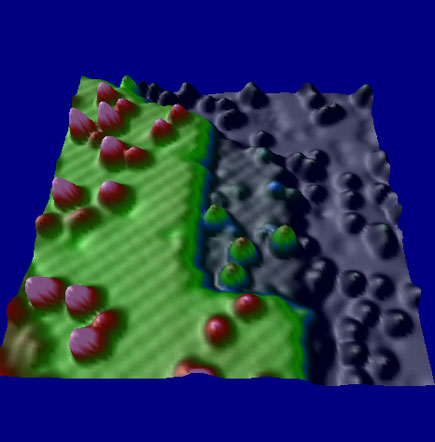
Cobalt atoms on ultra-thin NaCl layers on Cu(001)
|
|
 |
|
|
|
 |
 |
|
|
|
 |
| |
III) |
Detection and manipulation of spin states of individual magnetic atoms on graphene based on SP-STM
M. Wasniowska
|
|
|
| |
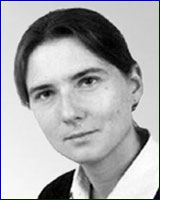 Graphene has recently attracted a great deal of attention due to its unique properties and the huge promise for applications. Graphene is a monolayer of carbon atoms arranged in a honeycomb lattice and has a novel electronic structure, with its conduction and valence bands meeting at the Dirac point. This characteristic enables the electrical transport to be tuned between hole or electron conduction by shifting the Fermi level with an applied electric field or by doping with atoms; it means that impurity states are important contributors to the unusual properties of graphene. Another important aspect is the influence of the magnetic impurities which are expected to significantly affect the electronic properties of graphene. Our research interest focuses on the study of individual magnetic atoms on graphene, which can show different magnetic properties depending on the concentration and the species of the atoms.
In this project, our aim is to use spin-polarized scanning tunneling spectroscopy/microscopy to explore these issues showing the local electronic and magnetic properties of the adsorbed magnetic adatoms and the graphene substrate.
|
|
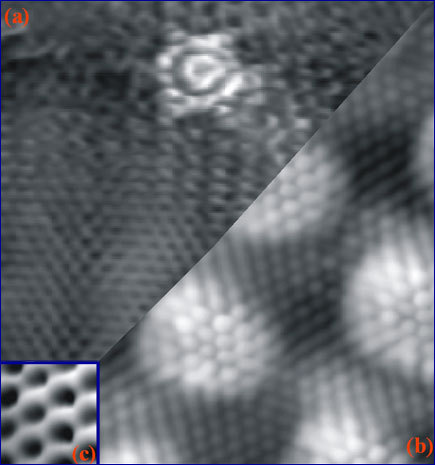
Atomic-resolution STM images of graphene: (a) on a SiC(0001) surface, (b) on a Ru(0001) surface and (c) close view of the graphene honeycomb lattice
|
|
 |
|
|
|
 |
 |
|
|
|
 |
| |
V) |
Detection of static and dynamic spin states of individual magnetic atoms in electrically insulating material systems based on MExFM
A. Schwarz
|
|
|
| |
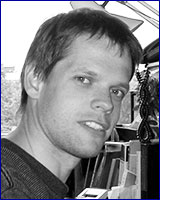 MExFM (Magnetic Exchange Force Microscopy) has proven its ability to map spin structures of insulating [1] and conducting [2] surfaces with atomic resolution. In this project we envisage to detect the spin state of individual magnetic atoms adsorbed on an electrically insulating surface with a force microcopy based set-up as sketched below. On metallic substrates strong hybridization effects alter the electronic structure as well as the magnetic properties of an adatom dramatically. Such hybridization effects are absent on insulating substrates, because all relevant states of an adatom are located in the band gap of the insulator. Thus, it will be possible to study the nearly undisturbed local magnetic properties of single atoms in real space. Since it is also possible to measure dissipative processes in a force microscopy set-up, it should be possible to investigate the dynamics of single atom spins as well, e.g., spin precession or single atom magnetization hysteresis. Such experiments must be performed at cryogenic temperatures to hinder diffusion and aggregation of the adsorbed atoms and to attain a sufficiently high force sensitivity and energy resolution. MExFM (Magnetic Exchange Force Microscopy) has proven its ability to map spin structures of insulating [1] and conducting [2] surfaces with atomic resolution. In this project we envisage to detect the spin state of individual magnetic atoms adsorbed on an electrically insulating surface with a force microcopy based set-up as sketched below. On metallic substrates strong hybridization effects alter the electronic structure as well as the magnetic properties of an adatom dramatically. Such hybridization effects are absent on insulating substrates, because all relevant states of an adatom are located in the band gap of the insulator. Thus, it will be possible to study the nearly undisturbed local magnetic properties of single atoms in real space. Since it is also possible to measure dissipative processes in a force microscopy set-up, it should be possible to investigate the dynamics of single atom spins as well, e.g., spin precession or single atom magnetization hysteresis. Such experiments must be performed at cryogenic temperatures to hinder diffusion and aggregation of the adsorbed atoms and to attain a sufficiently high force sensitivity and energy resolution.
|
|
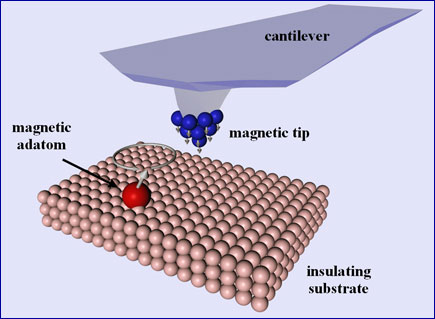
Principle of Magnetic Exchange Force Microscopy (MExFM)
| [1] |
U. Kaiser, A. Schwarz, and R. Wiesendanger,
Nature 446, 522 (2007).
|
| [2] |
R. Schmidt et al., Nano Lett. 9, 200 (2009). |
|
|
 |
|
|
|
 |
 |
|
|
|
 |
| |
VI) |
Coupling of the spin states of scanning probe tips and ultracold quantum gases
H. Zhong
|
|
|
| |
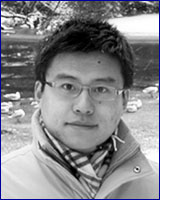 We intend utilizing a magnetic tip located at the free end of a cantilever as a sensitive force probe to study the spin degree of freedom of an ultracold quantum gas, i.e., a Bose-Einstein condensate (BEC). This kind of experimental set-up couples a quantum mechanical system to a classical mechanical solid state device. We envisage to explore the fundamental questions of decoherence at the transition between quantum and classical physics. Moreover, it might be possible to detect the resonant back action of this coupling by recording the mechanical response of the cantilever. To achieve the required sensitivity, the cantilever has to be cooled down to cryogenic temperatures. We intend utilizing a magnetic tip located at the free end of a cantilever as a sensitive force probe to study the spin degree of freedom of an ultracold quantum gas, i.e., a Bose-Einstein condensate (BEC). This kind of experimental set-up couples a quantum mechanical system to a classical mechanical solid state device. We envisage to explore the fundamental questions of decoherence at the transition between quantum and classical physics. Moreover, it might be possible to detect the resonant back action of this coupling by recording the mechanical response of the cantilever. To achieve the required sensitivity, the cantilever has to be cooled down to cryogenic temperatures.
The basic idea is sketched below: A BEC, e.g., Rb87 atoms in the |1, -1> hyperfine state, is confined in the center of a dipole trap generated by laser beams. The magnetic moment of the nearby tip Mtip generates a flux density Btip, This flux density can be used to manipulate the spin state of the BEC, e.g., by inducing spin flips into the |1, 0> hyperfine state. Moreover, the tip induced spin flips should also change the mechanical response of the cantilever, e.g., its frequency or amplitude. Our goal is to detect the back action as well.
|
|
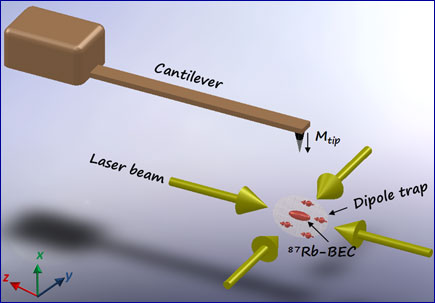
The cantilever tip carries a magnetic moment Mtip. If close to the trapped ultra-cold 87Rb atoms, tip-induced spin-flip transitions are provoked.
Thereby, the spin state of the BEC can be manipulated. Moreover, the back action of the cantilever can be detected as well by observing its mechanical response.
|
|
 |
|
|
|
 |
|
 Low-dimensional quantum magnetism is one of the hottest topics in condensed matter physics, especially after P. W. Anderson hypothesized that the quantum spin-liquid state called "Resonating Valence Bond" of CuO2 planes of High-TC superconductors plays an important role to achieve superconductivity at such high temperatures exceeding the BCS limit. However, the samples have been limited to bulk materials so far and the breakthrough to establish rigid theories did not come yet. Therefore, constructing and investigating various kinds of low-dimensional quantum spin systems in a bottom-up fashion are a long standing goal for condensed matter physicists. In this project we utilize spin-polarized STM, inelastic electron tunneling spectroscopy (IETS), and atom manipulation techniques on single magnetic atoms on metallic substrates covered by ultra thin insulating layers. First of all, we try to construct ideal low-dimensional quantum spin systems from single atomic spins with atom manipulation techniques. Once we reach the point to build these systems successfully, we want to investigate the magnetic states and excitations with spin-polarized STM and IETS to find out and unveil the exotic ground state properties. These experiments have to be performed at low temperatures (T<1 K) and high magnetic fields (B≈10 T).
Low-dimensional quantum magnetism is one of the hottest topics in condensed matter physics, especially after P. W. Anderson hypothesized that the quantum spin-liquid state called "Resonating Valence Bond" of CuO2 planes of High-TC superconductors plays an important role to achieve superconductivity at such high temperatures exceeding the BCS limit. However, the samples have been limited to bulk materials so far and the breakthrough to establish rigid theories did not come yet. Therefore, constructing and investigating various kinds of low-dimensional quantum spin systems in a bottom-up fashion are a long standing goal for condensed matter physicists. In this project we utilize spin-polarized STM, inelastic electron tunneling spectroscopy (IETS), and atom manipulation techniques on single magnetic atoms on metallic substrates covered by ultra thin insulating layers. First of all, we try to construct ideal low-dimensional quantum spin systems from single atomic spins with atom manipulation techniques. Once we reach the point to build these systems successfully, we want to investigate the magnetic states and excitations with spin-polarized STM and IETS to find out and unveil the exotic ground state properties. These experiments have to be performed at low temperatures (T<1 K) and high magnetic fields (B≈10 T). Graphene has recently attracted a great deal of attention due to its unique properties and the huge promise for applications. Graphene is a monolayer of carbon atoms arranged in a honeycomb lattice and has a novel electronic structure, with its conduction and valence bands meeting at the Dirac point. This characteristic enables the electrical transport to be tuned between hole or electron conduction by shifting the Fermi level with an applied electric field or by doping with atoms; it means that impurity states are important contributors to the unusual properties of graphene. Another important aspect is the influence of the magnetic impurities which are expected to significantly affect the electronic properties of graphene. Our research interest focuses on the study of individual magnetic atoms on graphene, which can show different magnetic properties depending on the concentration and the species of the atoms.
Graphene has recently attracted a great deal of attention due to its unique properties and the huge promise for applications. Graphene is a monolayer of carbon atoms arranged in a honeycomb lattice and has a novel electronic structure, with its conduction and valence bands meeting at the Dirac point. This characteristic enables the electrical transport to be tuned between hole or electron conduction by shifting the Fermi level with an applied electric field or by doping with atoms; it means that impurity states are important contributors to the unusual properties of graphene. Another important aspect is the influence of the magnetic impurities which are expected to significantly affect the electronic properties of graphene. Our research interest focuses on the study of individual magnetic atoms on graphene, which can show different magnetic properties depending on the concentration and the species of the atoms.

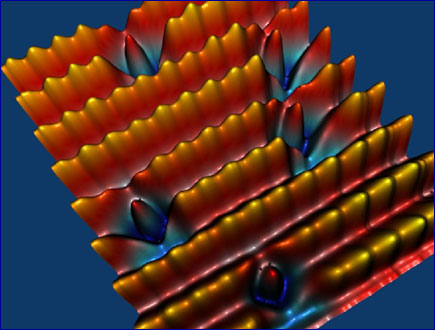

 Magnetic molecules contain spin centers in a chemically stable environment. Combined with their propensity of self-assembly and versatility of chemistry modifications, magnetic molecules provide one of the most promising candidates for future information technologies. Our research interest focuses on the study of molecular spin states at single molecule level on surfaces. In this project, we intend to explore the capability of using single molecule magnets, (kind of magnetic molecules which possess large magnetic anisotropy), for information storage with spin-polarized scanning tunneling microscopy and spectroscopy, which has proven to be a powerful tool for investigation of magnetism down to atomic scale. We expect to address the spin states of individual molecules with spin resolved spectroscopy and real-space spectroscopic mapping, and even be able to manipulate their spin orientations via spin torque exerted by spin-polarized tunneling electrons.
Magnetic molecules contain spin centers in a chemically stable environment. Combined with their propensity of self-assembly and versatility of chemistry modifications, magnetic molecules provide one of the most promising candidates for future information technologies. Our research interest focuses on the study of molecular spin states at single molecule level on surfaces. In this project, we intend to explore the capability of using single molecule magnets, (kind of magnetic molecules which possess large magnetic anisotropy), for information storage with spin-polarized scanning tunneling microscopy and spectroscopy, which has proven to be a powerful tool for investigation of magnetism down to atomic scale. We expect to address the spin states of individual molecules with spin resolved spectroscopy and real-space spectroscopic mapping, and even be able to manipulate their spin orientations via spin torque exerted by spin-polarized tunneling electrons.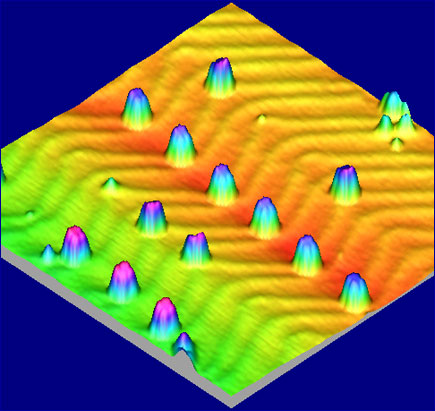
 MExFM (Magnetic Exchange Force Microscopy) has proven its ability to map spin structures of insulating [1] and conducting [2] surfaces with atomic resolution. In this project we envisage to detect the spin state of individual magnetic atoms adsorbed on an electrically insulating surface with a force microcopy based set-up as sketched below. On metallic substrates strong hybridization effects alter the electronic structure as well as the magnetic properties of an adatom dramatically. Such hybridization effects are absent on insulating substrates, because all relevant states of an adatom are located in the band gap of the insulator. Thus, it will be possible to study the nearly undisturbed local magnetic properties of single atoms in real space. Since it is also possible to measure dissipative processes in a force microscopy set-up, it should be possible to investigate the dynamics of single atom spins as well, e.g., spin precession or single atom magnetization hysteresis. Such experiments must be performed at cryogenic temperatures to hinder diffusion and aggregation of the adsorbed atoms and to attain a sufficiently high force sensitivity and energy resolution.
MExFM (Magnetic Exchange Force Microscopy) has proven its ability to map spin structures of insulating [1] and conducting [2] surfaces with atomic resolution. In this project we envisage to detect the spin state of individual magnetic atoms adsorbed on an electrically insulating surface with a force microcopy based set-up as sketched below. On metallic substrates strong hybridization effects alter the electronic structure as well as the magnetic properties of an adatom dramatically. Such hybridization effects are absent on insulating substrates, because all relevant states of an adatom are located in the band gap of the insulator. Thus, it will be possible to study the nearly undisturbed local magnetic properties of single atoms in real space. Since it is also possible to measure dissipative processes in a force microscopy set-up, it should be possible to investigate the dynamics of single atom spins as well, e.g., spin precession or single atom magnetization hysteresis. Such experiments must be performed at cryogenic temperatures to hinder diffusion and aggregation of the adsorbed atoms and to attain a sufficiently high force sensitivity and energy resolution.
 We intend utilizing a magnetic tip located at the free end of a cantilever as a sensitive force probe to study the spin degree of freedom of an ultracold quantum gas, i.e., a Bose-Einstein condensate (BEC). This kind of experimental set-up couples a quantum mechanical system to a classical mechanical solid state device. We envisage to explore the fundamental questions of decoherence at the transition between quantum and classical physics. Moreover, it might be possible to detect the resonant back action of this coupling by recording the mechanical response of the cantilever. To achieve the required sensitivity, the cantilever has to be cooled down to cryogenic temperatures.
We intend utilizing a magnetic tip located at the free end of a cantilever as a sensitive force probe to study the spin degree of freedom of an ultracold quantum gas, i.e., a Bose-Einstein condensate (BEC). This kind of experimental set-up couples a quantum mechanical system to a classical mechanical solid state device. We envisage to explore the fundamental questions of decoherence at the transition between quantum and classical physics. Moreover, it might be possible to detect the resonant back action of this coupling by recording the mechanical response of the cantilever. To achieve the required sensitivity, the cantilever has to be cooled down to cryogenic temperatures.